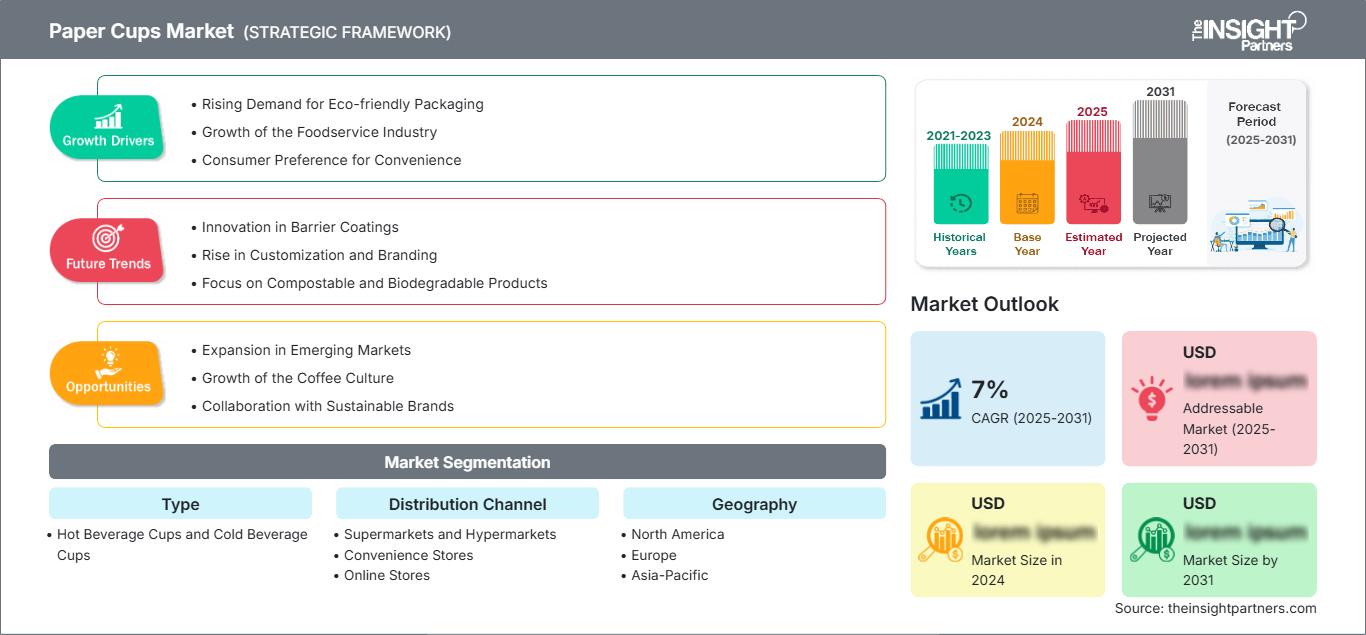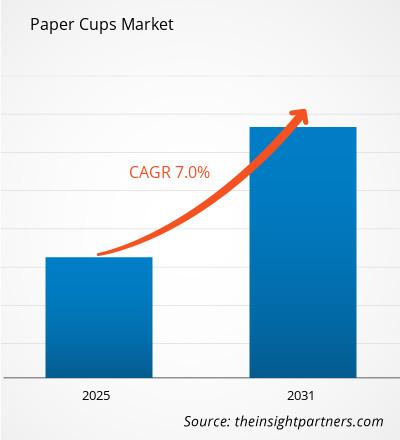Si prevede che il mercato dei bicchieri di carta registrerà un CAGR del 7% dal 2025 al 2031, con una dimensione del mercato in espansione da XX milioni di dollari nel 2024 a XX milioni di dollari entro il 2031.
Il rapporto è segmentato per tipologia (bicchieri per bevande calde e bicchieri per bevande fredde). Il rapporto presenta inoltre un'analisi basata sul canale di distribuzione (supermercati e ipermercati, minimarket, negozi online e altri). L'analisi globale è ulteriormente suddivisa a livello regionale e per i principali paesi. Il rapporto offre il valore in USD per l'analisi e i segmenti sopra indicati.
Scopo del rapporto
Il rapporto "Paper Cups Market" di The Insight Partners mira a descrivere il panorama attuale e la crescita futura, i principali fattori trainanti, le sfide e le opportunità. Ciò fornirà spunti a vari stakeholder aziendali, come:
- Fornitori/produttori di tecnologia: per comprendere le dinamiche di mercato in evoluzione e conoscere le potenziali opportunità di crescita, consentendo loro di prendere decisioni strategiche informate.
- Investitori: per condurre un'analisi completa delle tendenze in merito al tasso di crescita del mercato, alle proiezioni finanziarie del mercato e alle opportunità esistenti lungo la catena del valore.
- Organismi di regolamentazione: per regolamentare le politiche e le attività di polizia nel mercato con l'obiettivo di ridurre al minimo gli abusi, preservare la fiducia degli investitori e sostenere l'integrità e la stabilità del mercato.
Tipo di segmentazione del mercato dei bicchieri di carta
- Bicchieri per bevande calde e bicchieri per bevande fredde
Canale di distribuzione
- Supermercati e ipermercati
- Negozi di alimentari
- Negozi online
Potrai personalizzare gratuitamente qualsiasi rapporto, comprese parti di questo rapporto, o analisi a livello di paese, pacchetto dati Excel, oltre a usufruire di grandi offerte e sconti per start-up e università
Mercato dei bicchieri di carta: Approfondimenti strategici

- Ottieni le principali tendenze chiave del mercato di questo rapporto.Questo campione GRATUITO includerà l'analisi dei dati, che vanno dalle tendenze di mercato alle stime e alle previsioni.
Fattori di crescita del mercato dei bicchieri di carta
- Crescente domanda di imballaggi ecocompatibili: con le crescenti preoccupazioni ambientali, la domanda di soluzioni di imballaggio sostenibili ed ecocompatibili è in crescita, trainando il mercato dei bicchieri di carta. Poiché consumatori e aziende danno priorità alla sostenibilità, i bicchieri di carta, biodegradabili e riciclabili, sono diventati la scelta preferita rispetto ai bicchieri di plastica. La spinta verso alternative più ecologiche nel settore della ristorazione e delle bevande, comprese caffetterie e catene di fast food, ha aumentato significativamente la domanda di bicchieri di carta a livello globale.
- Crescita del settore della ristorazione: l'espansione del settore della ristorazione, in particolare nei ristoranti fast food, nelle caffetterie e nei bar, è un fattore chiave per il mercato dei bicchieri di carta. Con l'aumento degli stili di vita on-the-go, la necessità di bicchieri pratici e usa e getta è aumentata. I bicchieri di carta sono ampiamente utilizzati per bevande calde e fredde, come caffè, tè e bibite analcoliche, rendendoli una parte essenziale del settore della ristorazione. Questa crescente domanda sta alimentando la crescita del mercato.
- Preferenza dei consumatori per la praticità: poiché i consumatori conducono vite sempre più frenetiche, la domanda di prodotti usa e getta e pratici, come i bicchieri di carta, continua a crescere. I bicchieri di carta offrono una soluzione ideale per i consumatori che preferiscono bevande veloci e facili da usare. Questo fattore di praticità è particolarmente rilevante nelle caffetterie, nei cinema e negli eventi, dove il servizio rapido e la portabilità sono essenziali. Di conseguenza, il comportamento dei consumatori incentrato sulla praticità sta spingendo in avanti il mercato dei bicchieri di carta.
Tendenze future del mercato dei bicchieri di carta
- Innovazione nei rivestimenti barriera: una tendenza chiave che plasma il futuro del mercato dei bicchieri di carta è l'innovazione nei rivestimenti barriera. Poiché i bicchieri di carta devono contenere efficacemente i liquidi, i produttori si stanno concentrando sullo sviluppo di rivestimenti avanzati che prevengano le perdite e ne migliorino la durata. I rivestimenti ecologici a base d'acqua stanno diventando sempre più popolari come alternativa sostenibile ai rivestimenti in plastica. Queste innovazioni migliorano le prestazioni dei bicchieri di carta, mantenendone al contempo l'impatto ambientale.
- Aumento della personalizzazione e del branding: la domanda di imballaggi personalizzati e brandizzati è una tendenza in crescita nel mercato dei bicchieri di carta. Le aziende, soprattutto nel settore della ristorazione, si stanno sempre più concentrando sull'offerta di bicchieri personalizzati con design e loghi unici. I bicchieri di carta personalizzati non solo promuovono l'identità del marchio, ma offrono anche l'opportunità di migliorare l'esperienza del consumatore. Si prevede che questa tendenza guiderà il mercato, soprattutto con l'aumento dell'importanza del coinvolgimento dei consumatori con i marchi.
- Focus sui prodotti compostabili e biodegradabili: la crescente preferenza per i bicchieri di carta compostabili e biodegradabili è un'altra tendenza futura. In risposta alla crescente domanda di prodotti sostenibili, i produttori stanno sviluppando bicchieri realizzati con materiali di origine vegetale, come i rivestimenti in PLA (acido polilattico). Questo passaggio a opzioni completamente compostabili mira a ridurre gli sprechi e l'impatto ambientale dei bicchieri monouso, posizionando il mercato dei bicchieri di carta in linea con obiettivi di sostenibilità più ampi.
Opportunità di mercato per i bicchieri di carta
- Espansione nei mercati emergenti: il mercato dei bicchieri di carta offre significative opportunità di crescita nei mercati emergenti, in particolare nell'area Asia-Pacifico e in America Latina. Con l'aumento dell'urbanizzazione e del reddito disponibile, la domanda di soluzioni di imballaggio pratiche e sostenibili nel settore alimentare e delle bevande è in crescita. L'espansione in queste regioni consente alle aziende di soddisfare la crescente domanda di bicchieri di carta da parte dei consumatori, trainata da una classe media in rapida crescita e dalla proliferazione di ristoranti fast food.
- Crescita della cultura del caffè: l'ascesa globale della cultura del caffè rappresenta un'importante opportunità per il mercato dei bicchieri di carta. Con la crescente popolarità delle caffetterie specializzate, del caffè da asporto e del crescente consumo di caffè fuori casa, la domanda di bicchieri di carta è aumentata vertiginosamente. I marchi che offrono bicchieri di carta personalizzabili e di alta qualità per bevande calde possono accedere a questo mercato in crescita, che non mostra segni di rallentamento, nonostante il consumo di caffè continui ad aumentare in tutto il mondo.
- Collaborazione con marchi sostenibili: i produttori di bicchieri di carta hanno l'opportunità di collaborare con marchi attenti alla sostenibilità. Collaborando, le aziende possono produrre bicchieri di carta ecocompatibili, con particolare attenzione alla riciclabilità, alla compostabilità e alla riduzione al minimo degli sprechi. Mentre le aziende del settore della ristorazione e delle bevande si impegnano a raggiungere gli obiettivi di sostenibilità, i produttori possono posizionarsi come leader nella fornitura di soluzioni ecologiche per bicchieri monouso, rafforzando la propria presenza sul mercato e migliorando la reputazione del marchio.
Mercato dei bicchieri di carta
Le tendenze regionali e i fattori che influenzano il mercato dei bicchieri di carta durante il periodo di previsione sono stati ampiamente spiegati dagli analisti di The Insight Partners. Questa sezione analizza anche i segmenti e la geografia del mercato dei bicchieri di carta in Nord America, Europa, Asia-Pacifico, Medio Oriente e Africa, America meridionale e centrale.
Ambito del rapporto di mercato sui bicchieri di carta
| Attributo del rapporto | Dettagli |
|---|---|
| Dimensioni del mercato in 2024 | US$ XX million |
| Dimensioni del mercato per 2031 | US$ XX Million |
| CAGR globale (2025 - 2031) | 7% |
| Dati storici | 2021-2023 |
| Periodo di previsione | 2025-2031 |
| Segmenti coperti |
By Tipo
|
| Regioni e paesi coperti | Nord America
|
| Leader di mercato e profili aziendali chiave |
|
Densità degli operatori del mercato dei bicchieri di carta: comprendere il suo impatto sulle dinamiche aziendali
Il mercato dei bicchieri di carta è in rapida crescita, trainato dalla crescente domanda da parte degli utenti finali, dovuta a fattori quali l'evoluzione delle preferenze dei consumatori, i progressi tecnologici e una maggiore consapevolezza dei vantaggi del prodotto. Con l'aumento della domanda, le aziende stanno ampliando la propria offerta, innovando per soddisfare le esigenze dei consumatori e sfruttando le tendenze emergenti, alimentando ulteriormente la crescita del mercato.

- Ottieni il Mercato dei bicchieri di carta Panoramica dei principali attori chiave
Punti di forza
- Copertura completa: il rapporto analizza in modo esaustivo prodotti, servizi, tipologie e utenti finali del mercato dei bicchieri di carta, offrendo una panoramica olistica.
- Analisi degli esperti: il rapporto è redatto sulla base della conoscenza approfondita di esperti e analisti del settore.
- Informazioni aggiornate: il rapporto garantisce rilevanza aziendale grazie alla copertura di informazioni e tendenze dei dati recenti.
- Opzioni di personalizzazione: questo rapporto può essere personalizzato per soddisfare le esigenze specifiche del cliente e adattarsi in modo appropriato alle strategie aziendali.
Il rapporto di ricerca sul mercato dei bicchieri di carta può quindi aiutare a guidare il percorso di decodificazione e comprensione dello scenario del settore e delle prospettive di crescita. Sebbene possano esserci alcune preoccupazioni valide, i vantaggi complessivi di questo rapporto tendono a superare gli svantaggi.
- Analisi storica (2 anni), anno base, previsione (7 anni) con CAGR
- Analisi PEST e SWOT
- Valore/volume delle dimensioni del mercato - Globale, Regionale, Nazionale
- Industria e panorama competitivo
- Set di dati Excel
Report recenti
Rapporti correlati
Testimonianze
Motivo dell'acquisto
- Processo decisionale informato
- Comprensione delle dinamiche di mercato
- Analisi competitiva
- Analisi dei clienti
- Previsioni di mercato
- Mitigazione del rischio
- Pianificazione strategica
- Giustificazione degli investimenti
- Identificazione dei mercati emergenti
- Miglioramento delle strategie di marketing
- Aumento dell'efficienza operativa
- Allineamento alle tendenze normative




















 Ottieni un campione gratuito per - Mercato dei bicchieri di carta
Ottieni un campione gratuito per - Mercato dei bicchieri di carta